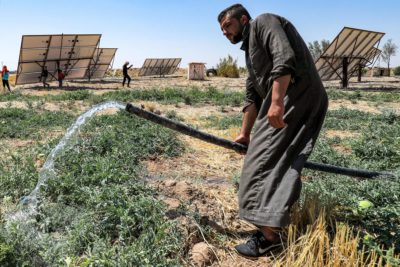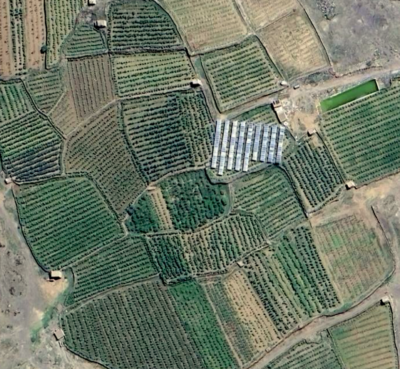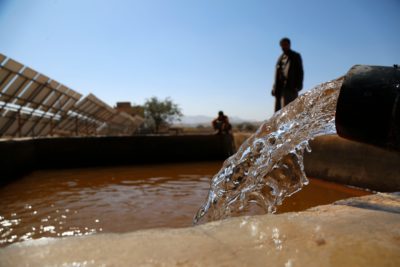There is a solar-powered revolution going on in the fields of India. By 2026, more than 3 million farmers will be raising irrigation water from beneath their fields using solar-powered pumps. With effectively free water available in almost unlimited quantities to grow their crops, their lives could be transformed. Until the water runs out.
The desert state of Rajasthan is the Indian pioneer and has more solar pumps than any other. Over the past decade, the government has given subsidized solar pumps to almost 100,000 farmers. Those pumps now water more than a million acres and have enabled agricultural water use to increase by more than a quarter. But as a result, water tables are falling rapidly. There is little rain to replace the water being pumped to the surface. In places, the underground rocks are now dry down to 400 feet below ground.
That is the effective extraction limit of the pumps, many of which now lie abandoned. To keep up, in what amounts to a race to the bottom of the diminishing reserves, richer farmers have been buying more powerful solar pumps, leaving the others high and dry or forcing them to buy water from their rich neighbors.
Water wipeout looms. And not just in Rajasthan.
The success of solar pumps is “threatening the viability of many aquifers already at risk of running dry,” says a World Bank economist.
Solar pumps are spreading rapidly among rural communities in many water-starved regions across India, Africa, and elsewhere. These devices can tap underground water all day long at no charge, without government scrutiny.
For now, they can be great news for farmers, with the potential to transform agriculture and improve food security. The pumps can supply water throughout the daylight hours, extending their croplands into deserts, ending their reliance on unpredictable rains, and sometimes replacing existing costly-to-operate diesel or grid-powered pumps.
But this solar-powered hydrological revolution is emptying already-stressed underground water reserves — also known as groundwaters or aquifers. The very success of solar pumps is “threatening the viability of many aquifers already at risk of running dry,” Soumya Balasubramanya, an economist at the World Bank with extensive experience of water policy, warned in January.
An innovation that initially looked capable of reducing fossil-fuel consumption while also helping farmers prosper is rapidly turning into an environmental time bomb.
Solar panels power pumping at a farm near Kafr el-Dawwar, Egypt. Khaled Desouki / AFP via Getty Images
For much of the 20th century, artificial irrigation of farmland boomed thanks to state and World Bank investment in reservoirs and in networks of canals to bring water to fields. Irrigation watered the “green revolution” of new high-yielding but thirsty crops, keeping a fast-growing world population largely fed.
But many systems have reached their limits. Rivers are being emptied, and new investment has dried up. So in the past three decades, hundreds of millions of farmers in hot arid regions, from Mexico to the Middle East and South Asia, have switched to getting their water from underground.
Boreholes sunk into porous water-holding rocks now provide 43 percent of the world’s irrigation water, according to a study last year by the World Bank. Irrigation is responsible for around 70 percent of the global underground water withdrawals, which are estimated at more than 200 cubic miles per year. This exceeds recharge from rainfall by nearly 70 cubic miles per year.
Monitoring of individual underground reserves is patchy at best. They are too often out of sight and out of mind. But a study of historical data from monitoring wells in 1,700 aquifers in 40 countries, published in January, reported that “rapid and accelerating” declines in reserves were widespread.
Scott Jasechko, a hydrologist at the University of California, Santa Barbara, found water tables dropping by 3 feet or more every year in India, Iran, Afghanistan, Spain, Mexico, the United States, Chile, Saudi Arabia, and other countries.
Aid agencies and governments subsidize solar pumps to boost food production, reduce poverty, and cut fossil fuel emissions.
The implications of this for the future are profound. “Groundwater depletion is becoming a global threat to food security, yet … remains poorly quantified,” says Meha Jain, who studies the sustainability of farming systems at the University of Michigan. But rather than calling a halt to groundwater withdrawals, policymakers are upping the ante by promoting solar power as a means of delivering yet more and cheaper underground water to fields.
The solar revolution on farms is happening with the best of intentions and is using a technology widely seen as environmentally beneficial. Farmers love the fact that their photovoltaic (PV) pumps do not require expensive and polluting diesel fuel or grid connections. Once installed, they can run all day at no cost, growing more food crops, or allowing their owners to expand their businesses — growing water-intensive cash crops, or earning income from selling spare water to neighbors. Many farmers also keep their old diesel or electric pumps to continuing pumping when the sun goes down.
Development agencies and governments are equally keen. They subsidize solar pumps to boost food production, reduce poverty, cut emissions from fossil fuels, and curtail growing demands on overstretched electricity grids. But the long-term downside of this solar revolution looms large.
Farmer Mohamed Ali al-Hussein waters a watermelon patch near Hasakeh, Syria with the help of a solar-powered pump. Delil Souleiman / AFP via Getty Images
The crisis is particularly stark in India. The world’s most populous nation “stands at the threshold of a revolution in adoption of solar irrigation pumps,” says Tushaar Shah, a water economist for the International Water Management Institute. The government intends to raise the number of solar pumps more than tenfold to 3.5 million by 2026.
The country is already the world’s largest consumer of groundwater, with farmers each year pumping onto their fields an estimated 50 cubic miles more water than the monsoon rains replace. Unchecked, says Shah, solar power is set to make the situation worse.
Sub-Saharan Africa could soon be on the same path. Shallow groundwater is present below fields in many places across the continent. But the cost of buying diesel fuel is prohibitively high for many farmers, and most rural areas are not connected to electricity grids. So, the arrival of stand-alone PV pumps is “a game-changer for small-scale farms” in sub-Saharan Africa, says Giacomo Falchetta, an energy and environment economist at the International Institute for Applied Systems Analysis in Austria.
There are already half a million PV irrigation pumps watering fields across the sub-Saharan region. But Falchetta calculates that in the future 11 million more could be deployed to irrigate 135 million acres of currently rainfed fields — an area the size of France. These pumps could supply a third of the unmet water needs of small farmers, who produce most of the food across sub-Saharan Africa.
Solar-powered farms in Yemen are pumping so hard they have triggered “a significant drop in groundwater since 2018.”
The main thing preventing farmers from accessing the free water beneath their feet is the capital cost of the equipment, which typically represents up to a year’s farm income. But that may soon change, as costs come down.
“The potential in Africa is large,” says Claudia Ringler, a water specialist at the Washington, D.C.-based International Food Policy Research Institute. “Solar power is a breakthrough technology. Barriers will be increasingly overcome, and it will transform agricultural irrigation.”
Falchetta reckons horticultural crops will benefit most from the extra water made available by solar pumps, “due to their high water requirement and high economic value.” But that rings alarm bells. Even modest falls in water tables in the continent’s many shallow aquifers could dry up wells that sustain many of the 255 million people living in poverty above them, warns the World Bank.
Such declines could also wreck fluvial ecosystems sustained by shallow underground water, including the wetlands and rivers on which millions of Africans depend for fish and other resources.
Overexploitation of groundwater, the World Bank review concludes, is “a classic tragedy of the commons — with exponential impacts disproportionately affecting the most vulnerable.” Yet the bank, along with its sister agency the Africa Development Bank, is funding stand-alone solar pump projects in Togo, Niger, and elsewhere across the continent.
In many places, however, farmers may not be able to wait for subsidies or aid projects to embrace solar pumps. They have little choice if they want to grow crops as other means of pumping water to their fields falter.
That is certainly the case in Yemen, on the south flank of the Arabian Peninsula, where the desert sands have a new look these days. Satellite images show around 100,000 solar panels glinting in the sun, surrounded by green fields. Hooked to water pumps, the panels provide free energy for farmers to pump out ancient underground water. They are irrigating crops of qat, a shrub whose narcotic leaves are the country’s stimulant of choice, chewed through the day by millions of men.
For these farmers, the solar irrigation revolution in Yemen is born of necessity. Most crops will only grow if irrigated, and the country’s long civil war has crashed the country’s electricity grid and made supplies of diesel fuel for pumps expensive and unreliable. So, they are turning en masse to solar power to keep the qat coming.
The panels have proved an instant hit, says Middle East development researcher Helen Lackner of SOAS University of London. Everybody wants one. But in the hydrological free-for-all, the region’s underground water, a legacy of wetter times, is running out.
The solar-powered farms are pumping so hard that they have triggered “a significant drop in groundwater since 2018 … in spite of above average rainfall,” according to an analysis by Leonie Nimmo, a researcher until recently at the U.K.-based Conflict and Environment Observatory. The spread of solar power in Yemen “has become an essential and life-saving source of power,” both to irrigate food crops and provide income from selling qat, he says, but it is also “rapidly exhausting the country’s scarce groundwater reserves.”
Farmers often use their solar pumps to supplement existing diesel-powered pumps, rather than replacing them.
In the central Sana’a Basin, Yemen’s agricultural heartland, more than 30 percent of farmers use solar pumps. In a report with Musaed Aklan, a water researcher at the Sana’a Center for Strategic Studies, Lackner predicts a “complete shift” to solar by 2028. But the basin may be down to its last few years of extractable water. Farmers who once found water at depths of 100 feet or less are now pumping from 1,300 feet or more.
Some 1,500 miles to the northeast, in in the desert province of Helmand in Afghanistan, more than 60,000 opium farmers have in the past few years given up on malfunctioning state irrigation canals and switched to tapping underground water using solar water pumps. As a consequence, water tables have been falling typically by 10 feet per year, according to David Mansfield, an expert on the country’s opium industry from the London School of Economics.
An abrupt ban on opium production imposed by Afghanistan’s Taliban rulers in 2022 may offer a partial reprieve. But the wheat that the farmers are growing as a replacement is also a thirsty crop. So, water bankruptcy in Helmand may only be delayed.
Water pours from a solar-powered pump near Sana'a, Yemen. Mohammed Mohammed / Xinhua / Alamy Stock Photo
“Very little is known about the aquifer [in Helmand], its recharge or when and if it might run dry,” according to Mansfield. But if their pumps run dry, many of the million-plus people in the desert province could be left destitute, as this vital desert resource — the legacy of rainfall in wetter times — disappears for good.
Even the potential climate benefits of solar pumping may prove illusory, says the World Bank’s Balasubramanya. In theory, switching from diesel or electricity to PV pumping should eliminate greenhouse gas emissions. But in practice, farmers often use their solar pumps to supplement existing pumps, rather than replacing them. And, however it is pumped, the extra water available will also encourage farmers to adopt more intensive farming methods, using more fertilizer and machinery to grow thirstier cash crops, increasing the carbon footprint of the farm.
What is to be done? Groundwaters are notoriously hard to police. India’s overpumping has been “a colossal anarchy,” says Shah. Some states have attempted to control non-solar pumps that run on grid electricity by restricting power supplies to farmers to a few hours every day. It had some effect, says Shah, who first proposed the idea. But many farmers responded by buying more powerful pumps.
Whatever the technology, “if the cost of pumping is zero, then people will pump unless some restriction is put on them.”
Now, to combat the excesses of solar pumps, Gujarat state has been paying some farmers high prices to use their PV panels to send power to the grid, rather than pump water, making solar energy in effect a new cash crop.
The pilot project was limited to just 4,300 wells, and again the benefit was “muted,” says Shah. He believes a better designed scheme could work. But Balasubramanya, who until recently worked with Shah in India, is doubtful. She warns that it might simply encourage more farmers to invest in solar panels, which could end up increasing water pumping further.
In any case, controls based around the electricity grid will not work in rural Africa, where there is rarely any grid for farmers to either tap into or supply.
None of this should be seen as a condemnation of solar power, says Balasubramanya. “The fundamental problem is not the solar technology itself.” Whatever the technology, “if the cost of pumping is zero, then people will pump unless some restriction is put on them.”
But Balasubramanya says technology could come to the rescue. If PV pumps had to be sold with sensors that allowed monitoring of their output, then regulators could directly limit their use. Whether governments would do that in practice, given the conflicting priorities between immediate food production and longer-term management of water, is another matter.







